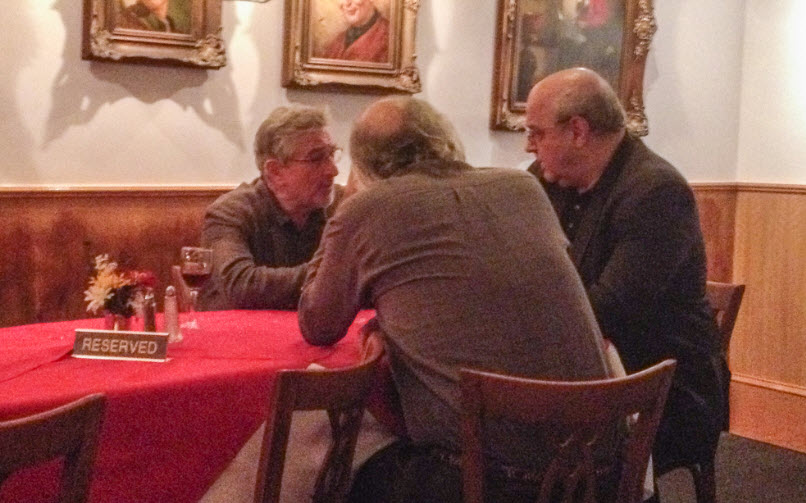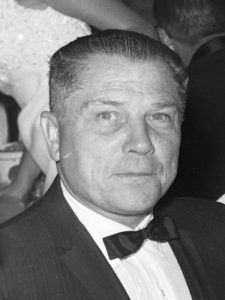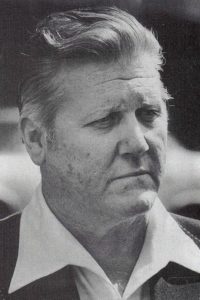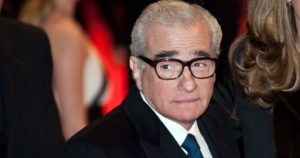Is the new Martin Scorsese movie based on a true story?
Journalist Dan Moldea makes the case against Frank Sheeran as Jimmy Hoffa’s killer

Editor’s note: The Irishman, a Martin Scorsese movie, was released today in a limited number of theaters across North America and Europe. It will be available for streaming on Netflix on November 27. Journalists and historians, knowing the movie is based on a best-selling book about the murder of Jimmy Hoffa, are debating the accuracy of the film’s depiction of who killed the labor leader in 1975. One of the top researchers on the Hoffa case over the past forty years is journalist Dan Moldea. What follows is an excerpt from Moldea’s book Confessions of a Guerrilla Writer: Adventures in the Jungles of Crime, Politics, and Journalism. Moldea also will be speaking on this subject December 11 at The Mob Museum.
During the spring of 2004, Eric Shawn, a reporter for Fox News, called and asked me to participate in a major news report that he was preparing on Charles Brandt’s upcoming book, I Heard You Paint Houses: Frank “The Irishman” Sheeran and the Inside Story of the Mafia, the Teamsters, and the Last Ride of Jimmy Hoffa.
Because the idea of the late Frank Sheeran telling this tale — regardless of his numerous lies and contradictions in the past — was so intriguing, I agreed to participate in Shawn’s report.(1) Inasmuch as I had already put Sheeran in the murder conspiracy in my 1978 book — as had Steve Brill in his own book — I really wanted Brandt to hit this one out of the ballpark in 2004. After all of these years, I hoped that the Hoffa case would finally be solved, once and for all.
To my surprise, on the acknowledgments page of his book, Brandt, with the concurrence of Sheeran, had written: “Thanks to those writers, such as Dan Moldea, Steven Brill, Victor Riesel, and [Jonathan] Kwitny, whose skillful investigative reporting, at risk of physical harm, uncovered and preserved so much of the history of Jimmy Hoffa, his times, and his disappearance.”

Also on the acknowledgements page, I could not help but notice that author Brandt’s literary agent for this project was Frank Weimann, who had sold my book about the O. J. Simpson case to Pocket Books.
Later in his text, Brandt stated that the first publisher-to-be of Sheeran’s controversial story had canceled the book — because of Sheeran’s credibility problems.(2) Consequently, Brandt wrote: “My agent, Frank Weimann, told Sheeran over the phone that if he wanted to get another publisher he would have to come clean and stand behind the book.”(3)
After speaking with Weimann, Sheeran had a conversation with his attorney, Emmett Fitzpatrick — the same lawyer who had threatened to sue me in 1979 because I had alleged that Sheeran was involved in the Hoffa murder conspiracy while Sheeran was claiming that he had not even been in Detroit on the day Hoffa disappeared. Fitzpatrick convinced Sheeran to be filmed, accepting the credit for killing Hoffa.
Brandt, upon turning on his video camera, noted that Sheeran “became hesitant and withdrawn.” However, he soon snapped out of his funk and agreed to hold up the galleys of his book while on camera, intoning what would become his mantra: “I stand behind what’s written.”
When Brandt tried to prod Sheeran to say something more, Sheeran replied on camera, “You have to go into questions, then one question leads to another. Let the book speak for itself.”
At that point, according to Brandt, “the camera battery died, and it was awhile before I discovered it and plugged the camera in.”(4)
On an earlier audio tape, however, Sheeran had told Brandt that he was the killer.
Weimann managed to sell the book to a second small publisher, Steerforth Press in Hanover, New Hampshire. The financial splits between Brandt and Sheeran’s family for the book’s royalties were not made public. However, it is fair to speculate that the business partnership between Brandt and Sheeran made Brandt less of a skeptical interviewer and more apt to embrace anything Sheeran said — which could help them publish this single-source manuscript, which had already been rejected by at least one other publisher.
After all, the clock was ticking. Sheeran, who was nearly broke and would be leaving little for his family, was about to die. And without Sheeran’s latest version of events in the wake of a long series of lies and deceptions, there would be no book.
Regardless, Brandt allowed himself to say during an interview on CNN, “[T]here’s no question that Sheeran is telling the truth. Interrogation and cross-examination … is my passion. I had him for five years. This was not an afternoon on the witness stand. And he was trying to unburden himself in his later years. He had returned to his Catholic faith [and] gotten absolution.”(5)
Even though I knew that Sheeran had something important to say, I also believed that he changed his story about his role as Hoffa’s actual killer in a cynical effort to salvage his book project so that he could leave his family some money — and for no other reason.
Frank Sheeran did not kill Jimmy Hoffa. Salvatore Briguglio did, based on everything I have seen and heard about this case since 1975.
* * *
Eric Shawn of Fox News broke the story about Brandt’s book on Sheeran on May 28. Shawn had interviewed Sheeran shortly before his death. Sheeran had supposedly admitted that he had killed Hoffa — just as the Dateline NBC producer told me the previous year — but, inexplicably, he refused to say so on camera to Fox News. From his hospital bed, he would only say, “I stand by what’s written in the book.”(6)
I agreed to appear in the report, repeating with considerable enthusiasm, “I’m convinced without any question that this is the biggest break in the Hoffa case since Hoffa disappeared on July 30, 1975. There’s no doubt in my mind about this.”(7)

However, reporter Shawn added: “Moldea … believes Sheeran was involved in Hoffa’s murder, but is skeptical if he actually fired the fatal shots.”
To me, the question of whether Hoffa’s killer was Frank Sheeran or Sal Briguglio was not a distinction without a difference. It went right to the heart of the issue of who was involved in the murder, as well as the motive behind it.
Earlier, on November 26, 1976, nearly a year after the FBI’s “Hoffex Memo” was written, Robert C. Stewart, the head of the U.S. Strike Force in Buffalo, sent a memorandum, “Status Report – Hoffa Investigation,” to Kurt W. Muellenberg, the acting chief of the Justice Department’s Organized Crime and Racketeering Section. In a discussion about Tony Provenzano’s failed attempt to solicit Hoffa to help Local 560, Stewart indicated that Sal Briguglio was given “the actual assignment” to kill Hoffa, stating:
“[I]n June and July of 1975 … Provenzano tried again to enlist Hoffa’s support through [Tony] Giacalone and that Hoffa gave a final refusal with a possible threat of exposure. The sequence of calls is suggestive of the proposition that, when Hoffa conclusively told Giacalone that he would not help Provenzano (7/18/75), Giacalone and Provenzano agreed to eliminate Hoffa; … that Briguglio was given the actual assignment and, thereafter, he notified the interested parties of its successful completion on the evening of 7/30/75 either personally or through a third party.”
What I did agree with was Sheeran’s very plausible account of what had preceded the actual murder, which author Brandt presented extremely well in his book.
According to Brandt, Sheeran claimed that Hoffa had earlier asked for his protection at Hoffa’s anticipated meeting with Tony Provenzano and Tony Giacalone on July 30, 1975.(8)
On the day of this scheduled meeting, Sheeran and his wife, along with Russell Bufalino and his wife, were driving from Pennsylvania to Detroit to attend the wedding of William Bufalino’s daughter. En route, Russell Bufalino directed Sheeran to make a stop off the Ohio Turnpike at an airport in Port Clinton, where a private plane was waiting. Leaving his wife and the Bufalinos behind at the airport, Sheeran was flown across Lake Erie to Pontiac Airport, near Detroit.
Upon his arrival, Sheeran climbed into a gray Ford and, with directions provided by Bufalino, drove to a three-story, brick-and-wood private residence at 17841 Beaverland Street in northwest Detroit.(9) There, Sheeran suggested, he met with Briguglio, as well as Tom and Steve Andretta, who had placed a roll of linoleum in the house’s foyer. Sheeran kept his car parked in the driveway.
Shortly after that, Chuck O’Brien allegedly drove up in a maroon automobile — unaware, according to Sheeran, of what was about to happen. Sheeran and Briguglio entered O’Brien’s car. Together, the three men drove to the Red Fox restaurant.
When they arrived at the restaurant at 2:45 p.m., an angry Hoffa complained that they had kept him waiting. Even though he expressed concern that neither Tony Provenzano nor Tony Giacalone was in the car, he trusted Sheeran, who was sitting in the front passenger’s seat, and stepped into the back seat behind Sheeran.
This was consistent with the statement of one of the alleged eyewitnesses interviewed by the FBI, who stated that he had seen Hoffa sitting in the back seat behind the front-seat passenger.
Briguglio sat next to Hoffa and behind O’Brien, according to Sheeran’s account.
To me, despite Sheeran’s past discrepancies, all of this rang true — and I was very excited when I first read it. There was no doubt in my mind: Hoffa had completely trusted Sheeran and would have gotten into the car with him.
With Sheeran’s confession, Brandt had been able to accomplish in 2003 what I just couldn’t do while I was writing my 1978 book: He placed Sheeran in the car with Hoffa. Back then, I believed that to be true, but I had absolutely no source information to support it.
Consequently, I simply portrayed Sheeran in The Hoffa Wars as an eyewitness who had possibly driven Hoffa’s killers from the Pontiac Airport to the scene of the crime. That was as far as my law enforcement sources could speculate with their limited inside information.

However, what I did not buy into was Sheeran’s tale of what happened after that. Sheeran claimed in his book that upon their return to the house on Beaverland Street, which was eight miles from the restaurant, he and Hoffa got out of the car. Then they walked through the front door and into the foyer where the roll of linoleum had been placed — while O’Brien and Briguglio drove away.
Significantly, Sheeran had earlier claimed that Briguglio’s primary role was to make sure that he did the job on Hoffa. However, Sheeran’s story had Briguglio leaving the scene before the actual crime was even committed.
Continuing his story, Sheeran told Brandt that when Hoffa entered the empty house, he immediately reacted to a suspected ambush:
“He turned fast, still thinking we were together on the thing, that I was his backup. Jimmy bumped into me hard. If he saw the piece in my hand he had to think I had it out to protect him. He took a quick step to go around me and get to the door. He reached for the knob and Jimmy Hoffa got shot twice at a decent range — not too close or the paint splatters back at you — in the back of the head behind his right ear. My friend didn’t suffer(10)
I wondered: Why the weasel words? Why didn’t Sheeran just flat out say, “I shot Hoffa twice,” instead of distancing himself from the act by saying, “Jimmy Hoffa got shot twice at a decent range”?
Also, I could not help but notice the similarities between Sheeran’s version of Hoffa’s murder and the manner in which the Joe Pesci character was killed, also in the entrance to a private residence, in the classic 1990 Martin Scorsese-Robert De Niro movie Goodfellas, which was based on Nicholas Pileggi’s best-selling book, Wiseguy.(11)
After supposedly killing Hoffa, Sheeran said he looked around to make sure that no one was there to kill him. Seeing he was safe, he climbed into the gray Ford that he had driven from the Pontiac Airport and returned to catch his private plane back to Port Clinton, Ohio, where he rejoined his wife and the Bufalinos.
Remarkably, according to Sheeran, the whole operation had only taken an hour. Then, together, the Sheerans and the Bufalinos resumed their drive to Detroit.
According to Sheeran, Bufalino later told him that Hoffa’s body had been incinerated, either at a trash disposal or at a funeral home.(12)
* * *
Fox News had gained entrance to the Beaverland Street home where Hoffa allegedly had been killed, authorizing crime scene investigators to search for any residue of blood in its foyer. Using Luminol, a chemical spray that illuminates blood, the forensics team discovered what appeared to be traces of blood, both in the foyer and in a hallway that led to the kitchen.
Everyone, including me, hoped the subsequent DNA analysis would show that this was Hoffa’s blood.
Repeating my own mantra that this “could be the biggest break in the Hoffa case,” David Ashenfelter added in his latest article:
“Moldea, who wrote an authoritative book about Hoffa and who has read Sheeran’s biography, said he still thinks Hoffa was killed by Sal Briguglio, not Sheeran. But Moldea said he believes Sheeran witnessed the crime because of the details he provided for the book. He said the book provides important new information that he thinks could help investigators.”(13)
In his remarkably uncritical analysis of Brandt’s book, Bryan Burrough of the New York Times Book Review actually celebrated Sheeran’s restraint in his tale of killing Hoffa, saying:
“[Sheeran’s] version of the murder involved a quick plane flight, an empty house, two well-placed bullets and a roll of linoleum. Sheeran was plainly conflicted about his task, but his retelling steers clear of the maudlin. “My friend didn’t suffer” is all he adds to the grisly details. Sheeran’s veracity is actually enhanced by his inability to say exactly what happened to Hoffa’s corpse, though he is confident that it did not end up at Giants Stadium.”(14)
* * *
On February 14, 2005, the Bloomfield Police Department issued a press release about the results of the DNA test of the blood residue found in the foyer of the home on Beaverland Street where Sheeran had supposedly killed Hoffa. The release stated:
“In late December 2004, the FBI contacted our department with an oral report on the findings. We were advised that blood was found in some of the wood floor samples but they did not believe that it matches Hoffa’s. They then indicated that the flooring submitted for examination, as well as a detailed written report would be forthcoming.
“This morning, we received a written report submitted by the FBI that concludes that human blood was found on wood flooring but the blood was not Hoffa’s. As a result, the lead supplied by Fox News in New York has been determined to be unfounded.”
Trying to give support to Brandt and Eric Shawn at Fox News, both of whom were extremely disappointed, I issued a statement, asserting:
“As I have been saying all along, Frank Sheeran was involved in Jimmy Hoffa’s murder — and, despite today’s news, the FBI believes this, as well. However, like the FBI, I have never believed Sheeran’s story about his role at the crime scene. Nevertheless, I continue to insist that Sheeran’s information about the events that preceded the actual murder — as reported in Charles Brandt’s book, as well as by Fox News and the Detroit Free Press — are extremely important to understanding what really happened to Hoffa on July 30, 1975.”
Endnotes
(1)Sheeran further suggested in the book that Hoffa and his friends in the Mafia were behind the assassination of President Kennedy in 1963. Specifically, Sheeran claimed he had delivered “a duffel bag with three rifles in it” to Carlos Marcello’s personal pilot, David Ferrie “a few days to a week before” the president’s murder (See: Brandt, pp. 163, 241-242.)
(2)Both Brandt and Sheeran had signed a publishing contract with Running Press Book Publishers, a subsidiary of Perseus Books, on May 8, 2003. The completed manuscript was due on June 1. Brandt and Sheeran received $20,000 upon signing the contract and were to receive another $20,000 upon publication. The copyright was in Brandt’s name alone.
(3)Charles Brandt, I Heard You Paint Houses: Frank “The Irishman” Sheeran & The Inside Story of the Mafia, the Teamsters, and the Last Ride of Jimmy Hoffa (Steerforth Press: Hanover, New Hampshire, 2004), p. 284.
(5)Transcript, CNN Live Saturday, “Charles Brandt, Author,” July 31, 2004.
(6)Eric Shawn, Fox News, “Detroit House Searched for Clues in Hoffa Case,” June 13, 2004. In addition, Sheeran confessed to twenty-five murders, including those of mobster Joey Gallo in 1972 and Salvatore Briguglio in 1978. Notably, along with the Hoffa hit, Sheeran’s self-proclaimed roles in these killings are in dispute.
(7)Eric Shawn, Fox News, “Detroit House Searched for Clues in Hoffa Case,” May 28, 2004.
(8)In yet another discrepancy, Sheeran sent a letter on March 15, 1993, to Hoffa’s daughter, Barbara Crancer, in which he included a handwritten note, saying: “On July 28 or July 29, 1975, I had a conversation with your Father on the phone. We set [an] appointment to meet Saturday, August 2, 1975 at his residence at Lake Orion, Michigan, as he was not going to attend Bill Bufalino’s daughter’s wedding [on] Aug 1, 1975, that was Friday evening.” Sheeran made no mention of Hoffa asking him for protection at the meeting with Giacalone and Provenzano.
(9)In 1975, the house was owned by an unmarried, retired schoolteacher, 79-year-old Martha Sellers, who had died in 1995. According to several sources, Sellers had an unnamed boarder, who rented an upstairs bedroom and had access to the entire house.
(11)Robert De Niro purchased the rights to the Sheeran-Brandt book and got together with Martin Scorsese, Al Pacino, and Joe Pesci to produce The Irishman, a motion picture based on that work. Oscar-winning screenwriter Steven Zaillian was commissioned to write the screenplay.
(12)Brandt, p. 261. Inspired by Brandt’s work, Jeffry Scott Hansen, a police officer, published his own book in 2009, Digging for the Truth: The Final Resting Place of Jimmy Hoffa (Spectre Publishing), in which he claimed that Hoffa’s body was cremated at Evergreen Cemetery in Detroit.
(13)David Ashenfelter, Detroit Free Press, “Was Hoffa killed inside this home?” May 29, 2004. After hearing about all this, a former top FBI official in Detroit sent me an email, simply saying, “I still think [Hoffa] was killed by Sal Briguglio, that Chuckie O’Brien was driving, and that he ended up in a mulching machine in Inkster.”
(14)Bryan Burrough, New York Times Book Review, “Killing Him Softly,” June 20, 2004.
Dan Moldea is a veteran investigative reporter and the author of several books, including The Hoffa Wars: The Rise and Fall of Jimmy Hoffa; Dark Victory: Ronald Reagan, MCA, and the Mob; Interference: How Organized Crime Influences Professional Football; and The Killing of Robert F. Kennedy: An Investigation of Motive Means, and Opportunity.
Feedback or questions? Email blog@themobmuseum.org





